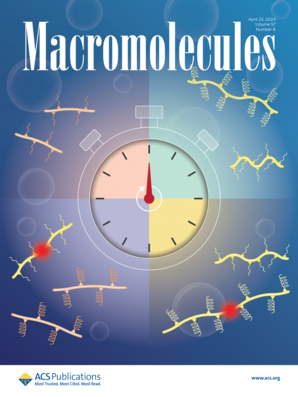Elucidation of the Termination Mechanism of the Radical Polymerization of Isoprene
IF 5.1
1区 化学
Q1 POLYMER SCIENCE
引用次数: 0
Abstract
The termination mechanism in the radical polymerization of isoprene (Ip), a representative diene monomer, was investigated through product analyses formed by the reaction of polyisoprene (PIp) model radicals and structurally controlled PIp end radicals. The results revealed that the termination occurred exclusively by combination (Comb) with >97% selectivity, regardless of the conditions, even in highly viscous media. This finding contrasts sharply with the termination mechanism in styrene polymerization, in which increasing viscosity shifts the termination mechanism entirely from Comb to disproportionation (Disp). Therefore, an extremely high propensity for Comb selectivity in Ip polymerization is demonstrated. Additionally, since Ip is used as a coupling agent in radical coupling reactions, these results also provide valuable insights into synthesizing new polymer materials based on IP-derived polymer end radical species.

异戊二烯自由基聚合终止机理的研究
通过聚异戊二烯(PIp)模型自由基与结构可控的PIp末端自由基反应生成的产物分析,研究了具有代表性的二烯单体异戊二烯(Ip)自由基聚合的终止机理。结果表明,无论条件如何,即使在高粘性介质中,组合(Comb)也能以97%的选择性终止。这一发现与苯乙烯聚合的终止机制形成鲜明对比,在苯乙烯聚合中,粘度的增加将终止机制完全从梳子转移到歧化(Disp)。因此,梳子选择性在Ip聚合中表现出极高的倾向。此外,由于Ip在自由基偶联反应中用作偶联剂,这些结果也为基于Ip衍生的聚合物末端自由基合成新的聚合物材料提供了有价值的见解。
本文章由计算机程序翻译,如有差异,请以英文原文为准。
求助全文
约1分钟内获得全文
求助全文
来源期刊

Macromolecules
工程技术-高分子科学
CiteScore
9.30
自引率
16.40%
发文量
942
审稿时长
2 months
期刊介绍:
Macromolecules publishes original, fundamental, and impactful research on all aspects of polymer science. Topics of interest include synthesis (e.g., controlled polymerizations, polymerization catalysis, post polymerization modification, new monomer structures and polymer architectures, and polymerization mechanisms/kinetics analysis); phase behavior, thermodynamics, dynamic, and ordering/disordering phenomena (e.g., self-assembly, gelation, crystallization, solution/melt/solid-state characteristics); structure and properties (e.g., mechanical and rheological properties, surface/interfacial characteristics, electronic and transport properties); new state of the art characterization (e.g., spectroscopy, scattering, microscopy, rheology), simulation (e.g., Monte Carlo, molecular dynamics, multi-scale/coarse-grained modeling), and theoretical methods. Renewable/sustainable polymers, polymer networks, responsive polymers, electro-, magneto- and opto-active macromolecules, inorganic polymers, charge-transporting polymers (ion-containing, semiconducting, and conducting), nanostructured polymers, and polymer composites are also of interest. Typical papers published in Macromolecules showcase important and innovative concepts, experimental methods/observations, and theoretical/computational approaches that demonstrate a fundamental advance in the understanding of polymers.
 求助内容:
求助内容: 应助结果提醒方式:
应助结果提醒方式:


